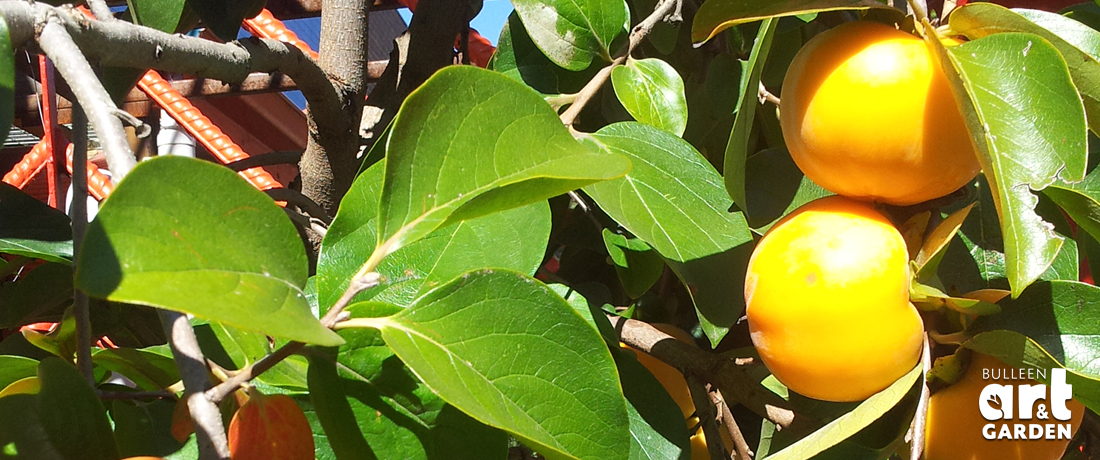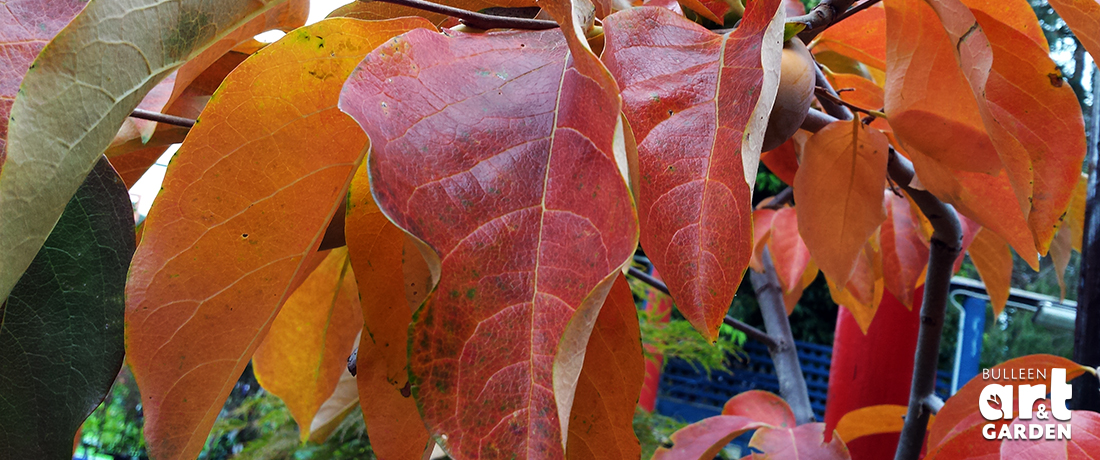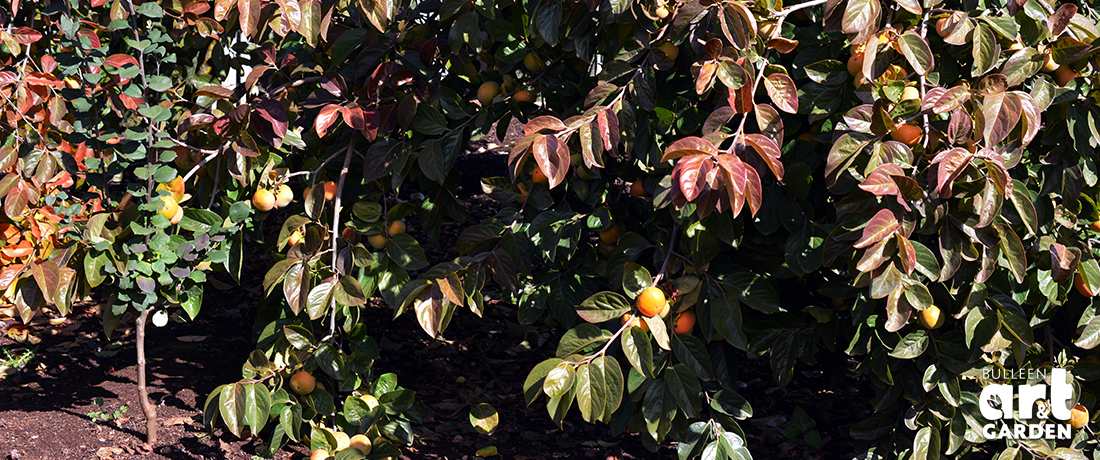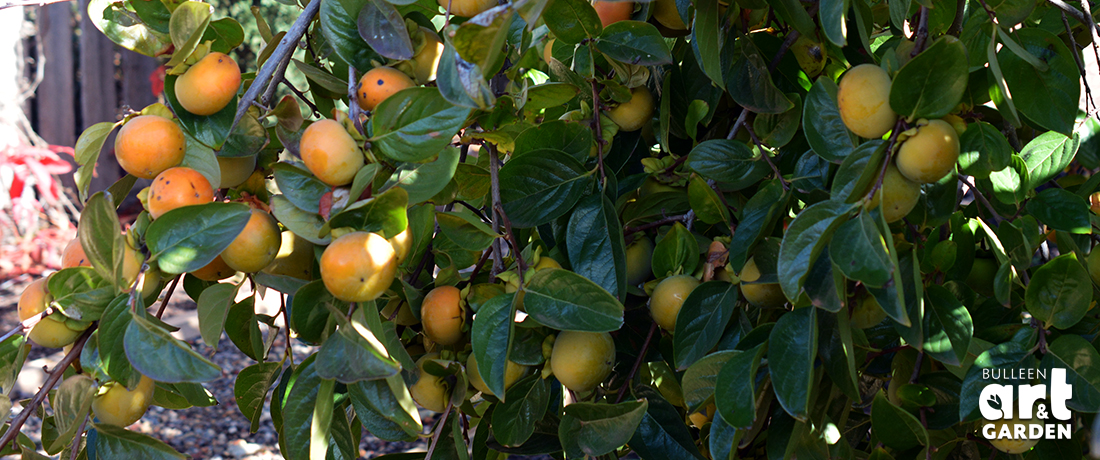
 Important note about plant availability. Important note about plant availability.There are hundreds of factsheets on our website provided for your information. Not all plants will be available at all times throughout the year. To confirm availability please call (03) 8850 3030 and ask for the nursery. |
Persimmon are a highly ornamental deciduous fruit tree with dense bright green foliage, spectacular orange and red autumn colours, light grey bark, and a beautiful twisted form in old age. In same cases, the large orange fruit are held on the bare branches after leaf-fall, creating a jeweled sculpture! Height is 3-10 m, tending to under 5m in the home garden.
Growing conditions
Persimmons require full sun, constant moisture in their root zone, and a climate with warm autumns to ripen fruit (particularly the non-astringent varieties). Young trees in particular need protection from wind, a weed-free root zone and free-draining soil –rich loams preferred, but even very sandy soils are tolerated.
Mulching & Feeding
Fertilise in late winter and early summer with heavy applications of manure, and keep well –mulched to suppress weed growth.

Pruning
Train to a pyramid (central leader) shape when starting off your young persimmon. The new growth that forms on the tips of last years wood, is where fruit will be produced, meaning DON’T prune this tree allover as you would an apple! Instead, in late winter, take out alternating branches each year (and any dead, broken, crossing or diseased wood), so that you leave room for new branches to go through the two years of growth without cutting that is required for them to produce fruit. Leave the remaining branches un-shortened, as it is the growth from from the tips of this wood that will flower and fruit this year.
Persimmon wood is brittle and branches can crack if the tree is overloaded with fruit. If this is a problem (young trees are especially vulnerable), thin out the fruit.

What does astringent mean?
Non-astringent varieties can be eaten when the colour has changed to orange yellow, but the fruit is still firm. Astringent varieties can only be eaten when fruit is very soft. It should, however, be picked when full colour depth is reached but the fruit is still firm. Then leave the fruit to ripen at room temperature.

Varieties
Fuyu (Vanilla)
Self-fertile. Non-astringent variety. May also be left to turn deep orange and soft. Medium-sized flat, seedless fruit, with attractive deep orange skin and sweet flavour. Slightly tougher skin helps the fruit to keep well. Can be eaten fresh, dried, and used in cooking. Late season maturity; mid May. Fruits on current season’s growth. Colourful autumn foliage.
Fuyu and Jiro have no male flowers so produce seedless fruit – but if a persimmon with male flowers is nearby, some pollination will occur, and seeds will result.
Dai Dai Maru
Self-fertile. Astringent variety. Medium-sized, flat, slightly, square fruit. Sweet and juicy with an orange-red skin when fully ripe. Can be eaten fresh, dried, and used in cooking. Early season maturity. Fruits on current seasons growth. Weeping tree with magnificent autumn foliage. A good home garden cultivar that produces heavy crops and requires minimal spraying.
Tanenashi
Self-fertile. Astrigent variety. HUGE, heart-shaped attractive fruit with golden orange skin, making this a very decorative tree. Fruit is seedless and flavour is sweet, however texture can be dry and grainy, meaning this is better regarded as a fruit for drying, or for its marvellous ornamental value. Mid-season maturity of fruit. Vigorous, heavy bearing tree, which begins producing at an early age, and features rusty orange autumn foliage.
Nightingale
Self-fertile. Astringent variety. Large, conical fruit, usually seedless and with matt-orange skin. Excellent flavour at full ripeness. Can be eaten fresh, dried, and used in cooking. Mid-season maturity. Fruits on current season’s growth, and is a heavy cropper. Dwarf variety with attractive autumn colour – ideal for small gardens. Needs minimal spraying. Ripens best on the tree.
Hyakume
Requires cross-pollination. Treat as Astringent variety for unseeded fruit, however many fruit will produce seeds, which give a cinnamon-brown colour and delicious sweetness to the flesh, even when still firm. Very large conical fruit with a blunt apex. Best eaten fresh. Mid-season maturity, brilliant red and yellow autumn colour.
Ichikikei Jiro
Self fertile. A bud sport of the Jiro. Leafs up a week later which may be handy if you are subject to late spring frosts. One of the most cold tolerant persimmons. Fruit is large and a little more square in shape. Otherwise very similar to the Jiro.
Jiro
A self fertile non-astringent semi dwarf variety. Drought and disease resistant and heat tolerant, mid season variety. Smooth, thin, shiny light orange skin and a sweet taste. If you eat the skin of the persimmon, then Jiro may be the one for you. Large (slightly larger than Fuyu) seedless fruit forming in abundant clusters.
Fuyu and Jiro have no male flowers so produce seedless fruit – but if a persimmon with male flowers is nearby, some pollination will occur, and seeds will result.
Maekawa Jiro
Self fertile. A bud sport of the Jiro, has rounder, less indented fruit and a beautiful flavour. Otherwise retains the same characteristics of the Jiro.
Wright’s Favourite
Self fertile. This is a true dwarf persimmon. Half the size of Tanenashi and Nightingale. Birdwood nursery (QLD) have a 30 year old plant at 2.2m tall. Fruit is full sized and deep orange.
Wright’s favourite is an astringent variety with a beautiful flavour, worththe wait for it to fully ripen! Self fertile.
Named for Lyle Wright OAM, plant breeder.
Fuyugaki
Self fertile. Another true dwarf persimmon. This one was developed by Lyle Wright at Hawksbury Agricultural College. It is a selection of Fuyu. Fuyu seeds were bought back after WWII and Fuyugaki was a dwarf selection from the seedlings. Self fertile.
Fuyugaki retains all the fantastic Fuyu qualities, but is a true dwarf form. Perfect for pot culture or grown where space is premium or simply by those who want minimal pruning requirements and easy netting if required. Medium-sized flat, seeded fruit, with attractive deep orange skin and sweet flavour. Fruits keep well. Can also be dried and used in cooking.
